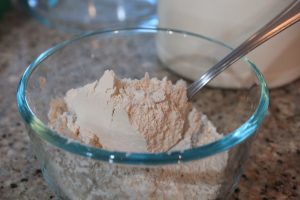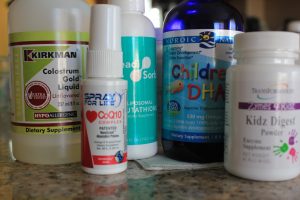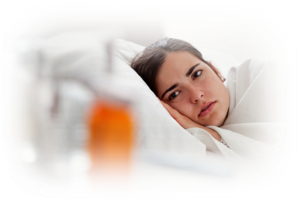
I suspected I had SIBO small intestinal bacterial overgrowth for a few years. I recently learned that that is what I have. I couldn’t or didn’t want to use the “normal” prescription for SIBO which is an antibiotic Rifaximin. While Rifaximin doesn’t get absorbed into the body, it can kill good bacteria as well as bad.
I got to thinking about the fact that diatomaceous earth also does not get “absorbed” into the body either because it is a cylinder like shape which has hard edges which scrape and cut bacteria, mucous, yeast, and parasites as traps or contains the pathogen and then it passes through the intestine and out of the body.
I figured if the antibiotic worked like that that I could try diatomaceous earth. I had purchases a 50-lb. bag a couple of years ago that I never used. I looked up the paperwork I got from www.sootheyoursoul.com about food grade diatomaceous earth and learned a lot. I’ll share some of it here since I found it very educational and helpful in my decision to use this while breastfeeding. They say there that it is ok for pregnant women to take DE. I figured if it is safe for pregnant women it would be safe for breastfeeding women.
If you want to know how to take this go to their website and get the full article or go to health practitioner that can muscle test how much would be good for you. I had my husband muscle test how much I needed to detox from yeast, mold, and fungus as well as heavy metals that I figured were in me since my daughter had such a toxic result from her heavy metal hair analysis (discussion for another blog.)
“Detoxification and cleansing of the intestines:
A single dosage supplies millions of tiny negatively charged diatoms, attracting positively charged bacteria, fungi, protozoa, viruses, endotoxins, pesticide and drug residues, E-coli, and heavy metals and traps them in the cylindrical structure, to be passed out of the body. It has also been reported to absorb methyl mercury…
Because these cylinders are very hard and have sharp edges, as they pass through the intestines, they “scrub” the walls of mucus, molds and old hardened toxic matter and sweep it out of the body. Food Grade DE has not been shown to cause any damage to the intestinal mucosa or barrier wall…
Detoxification improves the function of the immune system as it reduces the load of invaders challenging the immune system.
DE does not kill the beneficial bacteria in the gut.
DE is safe to use in pregnancy, it helps the mother better absorb nutrients from the food they eat, passing those on to the unboran child. It is best to start with a small dose of 1/2 teaspoon for the first few days and drink plenty of clean, pure water, and slowly increasing the dose to avoid detoxing too quickly.
Silica, which is abundant in Diatomaceous earth has many healing properties:
Silica prevents and even reverses osteoporosis. Research conducted by biophysicists Louis Kervan and Dr. Richard Barmakian pointed to the fact that silica was more important in bone formation and repair than calcium. Bones healed extremely well when low amounts of calcium were present with an abundance of silica.
Builds collagen and elastin which not only prevents wrinkles but is important in all connective tissues including cartilage, tendons, ligaments and vascular lining. It strengthens the body’s muscloskeletal system preventing injuries and speeding healing of fractures.
Regulates blood pressure by maintaining the structural integrity, elasticity and permeability for the arteries.
Silica is an essential building block for healthy hair, skin, and nails. It makes hair thicker, can prevent hair loss and has been reported to increase hair growth. It makes nails stronger and more flexible.
Trace minerals – Food Grade DE is a source of numerous trace minerals
Alkalizing agent (pH is 8.0)
It is organic listed in the OMRI (Organic Materials Review Institute)
Note: it was graded as “Chemical” grade since it acts like a chemical by dehydrating insects, but it is NOT a true chemical like a pesticide or insecticide.
Disclaimer: Any food grade diatomaceous earth uses other than those approved by the EPA, USDA, or FDA are strictly reports of what farmers, others and we ourselves have done with diatomaceous earth. The following material is not intended as a substitute for the advice of a physician or vet, nor is it intended to diagnose, treat, cure or prevent any disease.”
On the website there was a long list of specific uses for diatomaceous earth and while I was excited to use it to reduce excess yeast and fugus, it was also listed as a good way to detox from heavy metals as well as being alkalizing agent since it’s pH is 8.0.
So far, I can say that I have clearer thinking, more energy, and I will soon have my labs retested to see what has actually happened in my body. I am hoping and thinking that I will get some good results based on how I feel. And, while how I feel can be and is usually a good indicator of things, it is not the only barometer I used to determine what’s going on with my health.
Use your own intuition and good common sense about whether diatomaceous earth is good for you at this time in your health journey.
Please let us know how you’ve used DE and what results you got. We can all learn from each other.

